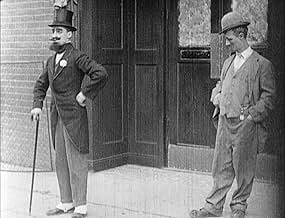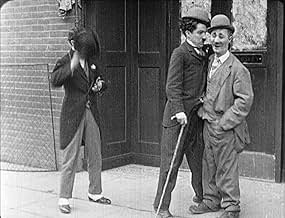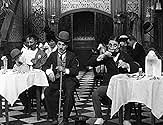After a visit to a pub, Charlie and Ben cause a ruckus at a posh restaurant. Charlie later finds himself in a compromising position at a hotel with the head waiter's wife.After a visit to a pub, Charlie and Ben cause a ruckus at a posh restaurant. Charlie later finds himself in a compromising position at a hotel with the head waiter's wife.After a visit to a pub, Charlie and Ben cause a ruckus at a posh restaurant. Charlie later finds himself in a compromising position at a hotel with the head waiter's wife.
Ben Turpin
- Fellow Reveller
- (uncredited)
Charles Allen Dealey
- Restaurant Manager
- (uncredited)
Frank Dolan
- Waiter
- (uncredited)
W. Coleman Elam
- Bit Role
- (uncredited)
Earl Esola
- Bellboy with Cigar Boxes
- (uncredited)
Eddie Fries
- Bit Role
- (uncredited)
Fred Goodwins
- Desk Clerk at Second Hotel
- (uncredited)
Madrona Hicks
- Veiled Woman
- (uncredited)
Bud Jamison
- Headwaiter
- (uncredited)
Daniel P. Kelleher
- Bellboy Carrying Suitcases
- (uncredited)
Edna Purviance
- Headwaiter's Wife
- (uncredited)
Eva Sawyer
- The Count's Companion
- (uncredited)
Lee Willard
- Soup Slurper
- (uncredited)
Fred Windemere
- Cop
- (uncredited)
- Director
- Writer
- All cast & crew
- Production, box office & more at IMDbPro
Featured reviews
Charlie Chaplin's 'A Night Out' is half an hour of the same sort of gag over and over again. Chaplin is drunk and together with another guy (Ben Turpin) he apparently is on a night out. They get kicked out of a bar, have some trouble with a waiter (Bud Jamison) there, his wife shows up as well to give us a little more fun, and out on the street a police officer is doing his rounds.
Basically we see Chaplin smack someone in the face, the waiter or the other guy, or even the waiter's wife, and then he gets smacked in the face. The physical action that follows is quite nice but after five minutes we get the joke, after watching 25 minutes more we are kind of tired of it.
The reason to see this short, besides Chaplin's skill, is because Edna Purviance plays the wife of the waiter. This is her first film with Chaplin and that makes it a little more interesting. I squeeze it with a six (out of ten).
Basically we see Chaplin smack someone in the face, the waiter or the other guy, or even the waiter's wife, and then he gets smacked in the face. The physical action that follows is quite nice but after five minutes we get the joke, after watching 25 minutes more we are kind of tired of it.
The reason to see this short, besides Chaplin's skill, is because Edna Purviance plays the wife of the waiter. This is her first film with Chaplin and that makes it a little more interesting. I squeeze it with a six (out of ten).
'A Night Out' stands out only as Edna Purviance's debut. There isn't much plot - the film plays as one running gag concentrating on the antics of drunken Tramp. Drunk Tramp is not usually the most pleasant character and this is the case in this one. And the film doesn't differ much from previous pictures where Charles Chaplin has portrayed trouble making drunk. Although, I have to admit, that this movie is a little more balanced between slapstick and lighter humor. Scenes are staged better and with more attention to detail - not all the energy has gone into drunken slapstick, although, there is plenty of that. Mildly amusing but not overly hilarious. The biggest problem was that it became repetitive rather quickly and thus felt like the movie dragged too much. Ben Turpin knows how to take the fall but that is the only thing he has to offer to this movie. There wasn't much dynamic between him and Chaplin like there was in their previous collaboration 'His New Job'. It is clear that Chaplin still learned the ways of making interesting movies and his progress as a director is showing but 'A Night Out' is still a work of a prentice who's just learned the basics of the craft.
Am a big fan of Charlie Chaplin, have been for over a decade now. Many films and shorts of his are very good to masterpiece, and like many others consider him a comedy genius and one of film's most important and influential directors.
From his Essanay period after leaving Keystone, 'A Night Out' is not one of his very best or even among the best of this particular period. It shows a noticeable step up in quality though from his Keystone period, where he was still evolving and in the infancy of his long career, from 1914, The Essanay period is something of Chaplin's adolescence period where his style had been found and starting to settle. Something that can be seen in the more than worthwhile 'A Night Out'.
'A Night Out' is not one of his all-time funniest or most memorable, other efforts also have more pathos and a balance of that and the comedy. The story is still a little flimsy, there are times where it struggles to sustain the short length, and could have had more variety and less more of the same repeition.
On the other hand, 'A Night Out' looks pretty good, not incredible but it was obvious that Chaplin was taking more time with his work and not churning out countless shorts in the same year of very variable success like he did with Keystone. Appreciate the importance of his Keystone period and there is some good stuff he did there, but the more mature and careful quality seen here and later on is obvious.
While not one of his funniest or original, 'A Night Out' is still very entertaining with some clever, entertaining and well-timed slapstick. It moves quickly and there is no dullness in sight.
Chaplin directs more than competently, if not quite cinematic genius standard yet. He also, as usual, gives an amusing and expressive performance and at clear ease with the physicality of the role. The supporting cast acquit themselves well, with an amusing Ben Turpin and charming Edna Purviance in her first collaboration with Chaplin.
In summation, worth watching if not to watch over and over. 7/10 Bethany Cox
From his Essanay period after leaving Keystone, 'A Night Out' is not one of his very best or even among the best of this particular period. It shows a noticeable step up in quality though from his Keystone period, where he was still evolving and in the infancy of his long career, from 1914, The Essanay period is something of Chaplin's adolescence period where his style had been found and starting to settle. Something that can be seen in the more than worthwhile 'A Night Out'.
'A Night Out' is not one of his all-time funniest or most memorable, other efforts also have more pathos and a balance of that and the comedy. The story is still a little flimsy, there are times where it struggles to sustain the short length, and could have had more variety and less more of the same repeition.
On the other hand, 'A Night Out' looks pretty good, not incredible but it was obvious that Chaplin was taking more time with his work and not churning out countless shorts in the same year of very variable success like he did with Keystone. Appreciate the importance of his Keystone period and there is some good stuff he did there, but the more mature and careful quality seen here and later on is obvious.
While not one of his funniest or original, 'A Night Out' is still very entertaining with some clever, entertaining and well-timed slapstick. It moves quickly and there is no dullness in sight.
Chaplin directs more than competently, if not quite cinematic genius standard yet. He also, as usual, gives an amusing and expressive performance and at clear ease with the physicality of the role. The supporting cast acquit themselves well, with an amusing Ben Turpin and charming Edna Purviance in her first collaboration with Chaplin.
In summation, worth watching if not to watch over and over. 7/10 Bethany Cox
Viewers interested in Charlie Chaplin's early work (i.e. the rough stuff, with lots of drunken foolery and butt-kicking) may well enjoy this film. I confess I enjoyed it, the way I might get a kick out of watching Championship Wrestling for twenty minutes or so. If it's Chaplin the Artiste you want then try the later productions, but if you're in the mood for rude and unrefined slapstick then A Night Out should fit the bill nicely.
This is the second film Chaplin made for the Essanay company, and it also marks the second and last time he teamed up with knockabout comic Ben Turpin. Chaplin and Turpin don't pair especially well on screen, and it's said they didn't get along off-camera either, which is no surprise. Chaplin was a gifted mime, an inspired comedian and an exacting filmmaker, while Turpin was a low-comedy clown with crossed eyes. Ben could take a fall with the best of them, but it's said he didn't understand why Chaplin the perfectionist demanded take after take of each scene. There in a nutshell you have the difference between an artist and a hack.
As it happens, despite the modest trappings of this film Chaplin's special gift comes across in several nice little moments. Early on, during the sequence in a swanky restaurant, the drunken Charlie stands at an indoor fountain and suddenly seems to believe he's washing up in the privacy of his own home, so naturally enough he brushes his teeth with the stem of a plant. It's a strange bit of business, almost dreamlike, but Chaplin makes it appear perfectly normal and routine. Later, checking into a hotel, Charlie attempts to rest his foot on the bar rail -- which happens to be invisible -- and drink ink from the inkwell.
This film is most notable as the debut of Chaplin's longtime leading lady Edna Purviance, who was only 19 years old at this time and very pretty indeed. Her first scenes are fairly low-key, but later on, when she's in pajamas playing with her dog, Chaplin grants Edna a couple of close-ups which look something like a screen test. Obviously she passed the test with flying colors, for Edna went on to play opposite Chaplin in virtually every film he made for the next eight years, the happiest and most prolific period of his creative life. If for no other reason, A Night Out is worth seeing for the debut of this beautiful and underrated silent screen actress.
This is the second film Chaplin made for the Essanay company, and it also marks the second and last time he teamed up with knockabout comic Ben Turpin. Chaplin and Turpin don't pair especially well on screen, and it's said they didn't get along off-camera either, which is no surprise. Chaplin was a gifted mime, an inspired comedian and an exacting filmmaker, while Turpin was a low-comedy clown with crossed eyes. Ben could take a fall with the best of them, but it's said he didn't understand why Chaplin the perfectionist demanded take after take of each scene. There in a nutshell you have the difference between an artist and a hack.
As it happens, despite the modest trappings of this film Chaplin's special gift comes across in several nice little moments. Early on, during the sequence in a swanky restaurant, the drunken Charlie stands at an indoor fountain and suddenly seems to believe he's washing up in the privacy of his own home, so naturally enough he brushes his teeth with the stem of a plant. It's a strange bit of business, almost dreamlike, but Chaplin makes it appear perfectly normal and routine. Later, checking into a hotel, Charlie attempts to rest his foot on the bar rail -- which happens to be invisible -- and drink ink from the inkwell.
This film is most notable as the debut of Chaplin's longtime leading lady Edna Purviance, who was only 19 years old at this time and very pretty indeed. Her first scenes are fairly low-key, but later on, when she's in pajamas playing with her dog, Chaplin grants Edna a couple of close-ups which look something like a screen test. Obviously she passed the test with flying colors, for Edna went on to play opposite Chaplin in virtually every film he made for the next eight years, the happiest and most prolific period of his creative life. If for no other reason, A Night Out is worth seeing for the debut of this beautiful and underrated silent screen actress.
One of Chaplin's better efforts from his early days at Essanay which isn't really that much of a recommendation, as both Chaplin and his creation were far from the finished article when this was made. With his exaggerated motions and heavy-eyed contemplation of things he can't quite understand due to his inebriated state, Chaplin exquisitely captures the behaviour of one who has had more than one too many. He's partnered for the first time with Edna Purviance here, and they work well together. The story itself is typical of the violence with which Chaplin's work seemed to be obsessed at this time. He had obviously found a formula that worked
Did you know
- TriviaThis was Edna Purviance's first film with Charles Chaplin.
- GoofsThe hotel number for Reveller (Charlie Chaplin) and Fellow Reveller changes. When Fellow Reveller first enters the room the number on the door is clearly visible as 3. When Reveller is followed into the room by Headwaiter the room number changes to 2. It changes back to 3 when Fellow Reveller leaves the room for the final time.
- ConnectionsEdited into The Essanay-Chaplin Revue of 1916 (1916)
Details
- Release date
- Country of origin
- Official sites
- Languages
- Also known as
- Charlot en bombe
- Filming locations
- Production company
- See more company credits at IMDbPro
- Runtime
- 34m
- Color
- Sound mix
- Aspect ratio
- 1.33 : 1
Contribute to this page
Suggest an edit or add missing content



























